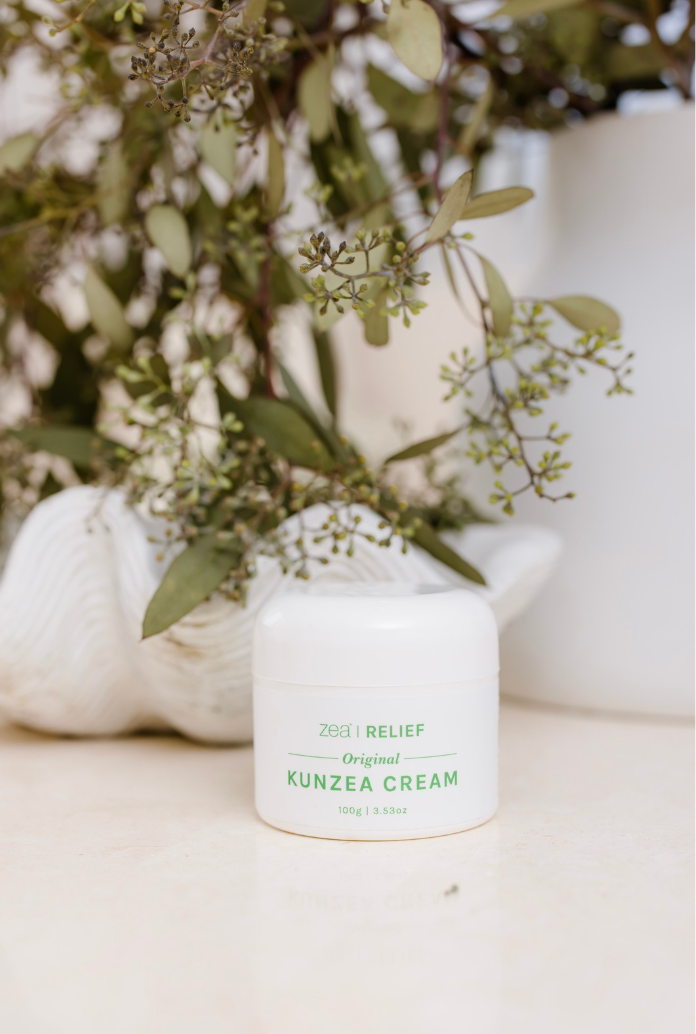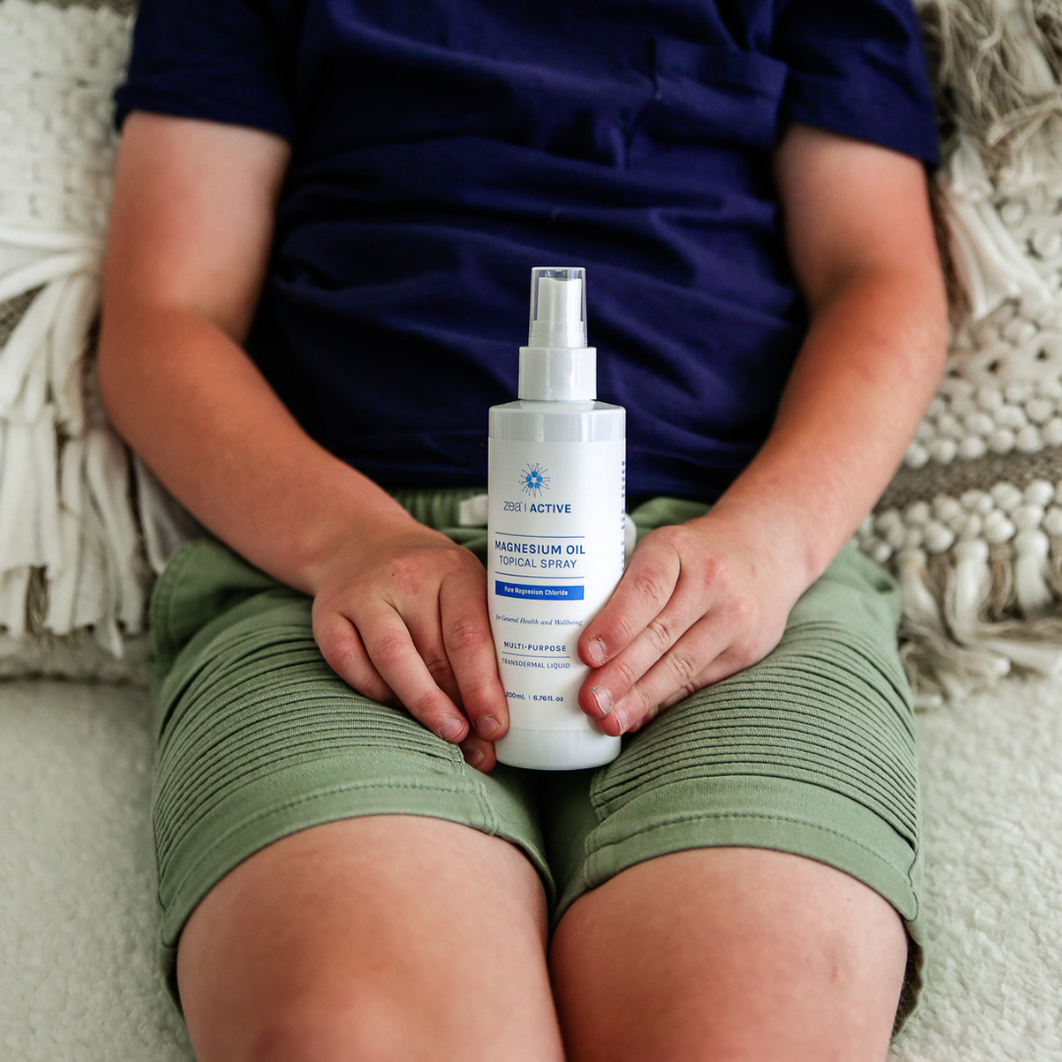Zea Relief Kunzea Pain Relief Cream (ARTG 360331) has gained significant popularity as a trusted natural solution for alleviating pain and discomfort. This multi-active formulation harnesses the power of Kunzea Oil, a native Australian extract renowned for its anti-inflammatory and analgesic properties, combined with other carefully selected natural ingredients. Together, these ingredients work synergistically to target the underlying pathways of pain and inflammation, providing effective relief for sore muscles, joint aches, and general discomfort.
In this article, we’ll explore the unique science behind how Zea Relief Kunzea Pain Relief Cream works, uncovering the natural bioactive benefits that make it a standout choice for those seeking a natural alternative to synthetic pain relief solutions.
What causes inflammation?
Inflammation is a natural defence mechanism of the body, triggered in response to injury, damage, infection, or chronic wear and tear. When the body detects harm, it releases chemical messengers called cytokines, which signal the immune system to take action. This process leads to common symptoms such as redness, swelling, heat, and pain in the affected area.
While inflammation is essential for healing, excessive or prolonged inflammation can result in chronic pain and discomfort, often associated with conditions like arthritis, muscle strains, or joint injuries. Understanding the causes of inflammation is key to finding effective relief, whether through natural remedies like Zea Relief products or other targeted solutions.
Why do we experience pain?
Pain is primarily communicated through nerve fibres that relay signals to the brain. When tissue is damaged, chemical messengers trigger inflammation, drawing immune cells and cytokines to the area. These cytokines heighten pain sensitivity, and if the body cannot repair the damage, the pain may become chronic.
In chronic pain, the cyclooxygenase enzyme (COX-2), which is responsible for releasing prostaglandins during injury and plays a major role in inflammation, is produced at injury sites, releasing prostaglandins that activate pain receptors and intensify pain. Oral COX-2 inhibitors are often ineffective because they don’t target the damaged area, whereas topical applications can directly inhibit COX-2 production, reducing inflammation and pain exactly where you need it.
Effective pain relief depends on the absorption of active ingredients into the skin. Terpene-rich essential oils, like Kunzea, excel at penetrating the skin. The terpene content helps to temporarily disrupt the skin barrier for deeper absorption.
Skin cells (keratinocytes) communicate with sensory nerves, influencing pain perception. Topical applications of many topical-rich essential oils, such as Kunzea, Lavender, Rosemary and Eucalyptus, can soothe these nerves immediately.
TRPV channels play a key role in detecting tissue damage and inflammation, signalling pain to the brain. Two important TRPV channels are:
- TRPV1: Detects heat, nerve pain, and inflammation.
- TRPM8: Senses cold.
The lipid-soluble nature of essential oils allows them to cross cell membranes and block TRPV1 activation, mitigating pain signals. Key components from Kunzea, Lavender, and Rosemary inhibit TRPV1 and reduce inflammatory cytokine production, decreasing pain and swelling.
Moreover, Zea Relief Kunzea Pain Relief Cream contains natural emollients like Vitamin E, Jojoba and Shea Butter, which nourish the skin and support healing, enhancing the skin's resilience against further damage.
How each key active works on its own
Kunzea (Kunzea ambigua) is the key ingredient within the Zea Relief Kunzea Pain Relief Cream and most Zea Relief products. It is a native Australian essential oil that has powerful anti-inflammatory properties and is unique for its biochemistry of several C15 (sesquiterpene) compounds. Five of these compounds include globulol, viridiflorol, spathulenol, ledol and bicyclogermacrene. Sesquiterpene compounds are known for its powerful anti-inflammatory effect, giving Kunzea its distinctiveness to fight inflammation.
Another unique property of Kunzea is its chemical structure of its two major monoterpene constituents; alpha-pinene and 1,8-cineole, with pinene being present in a larger amount than the cineole, which is the opposite for other essential oils. Because of this unique biochemistry ratio, Kunzea is a non-irritant and more skin friendly than other essential oils, even at 100% concentration.
Rosemary (Rosmarinus officinalis) has significant antimicrobial, anti-inflammatory, antioxidant, antinociceptive, anti-apoptotic and neuroprotective properties. It has also proven to have therapeutic and calming effects on mood, anxiety, sleep and pain. Some of the key constituents within Rosemary include rosmarinic acid, carnosic acid and carnosol, which constitute the most medicinal properties to work their magic in producing anti-inflammatory and antioxidant effects.
Once rosemary has entered the bloodstream, it inhibits the activation of NF-kB, which is crucial for maintaining immune responses and inflammation. By suppressing the production of NF-kB, rosemary causes less pro-inflammatory genes to be produced. This inhibition leads to the suppression of COX-2 production, resulting in a reduced production of inflammation and inflammatory cytokines.
Lavender (Lavandula angustifolia) has been proven to be rich in medicinal properties including anti-inflammatory, antimicrobial and antioxidant properties. NF-kB is the key regulator of immune responses and inflammation. One of Lavender’s key compounds is linalool, which works to suppress the activation of NF-kB, therefore reducing the amount of pro-inflammatory genes that get produced.
Lavender is also known to decrease the production of pro-inflammatory cytokines including TNF-a, IL-6 and IL-8. These cytokines promote inflammation by gathering more immune cells to the site of tissue damage and increasing inflammation. By reducing the production of these, lavender works to decrease and maintain inflammation.
Vitamin E is a fat soluble compound that consists of tocopherols and tocotrienols. It has known antioxidant and anti-inflammatory properties. Vitamin E has the ability to inhibit and suppress the production of pro-inflammatory cytokines such as IL-6, IL-1 and TNF-a. These cytokines are responsible for promoting inflammation during infection, and an overproduction of these cytokines cause inflammatory conditions such as arthritis. Through suppressing their production, Vitamin E works to reduce inflammation and suppress the pain that inflammation causes.
Furthermore, Vitamin E works by suppressing COX-2, which is heavily involved in the production of inflammatory prostaglandins, which cause pain and inflammation. Vitamin E has powerful antioxidant properties, specifically its alpha-tocopherol form. Free radicals and reactive oxygen species are produced during inflammation and can damage tissues, Vitamin E scavenges for these and helps neutralise these toxic molecules.
Its powerful antioxidant properties also work to protect the skin from oxidative damage, as vitamin E helps neutralise free radicals, it protects the skin from UV radiation and reduces the risk of DNA damage in skin cells. Vitamin E is also known for its hydrating properties as it is an emollient, it maintains hydration in skin by enhancing and strengthening its outer layer, locking in moisture.
How the key actives work together to relieve pain
The active anti-inflammatory effects found in Kunzea, Rosemary, Lavender and Vitamin E work together to reduce inflammation and swelling in muscles and joints. With Vitamin E being a natural antioxidant, it perfectly complements its partnering ingredients by working to protect tissues from any oxidative damage caused by inflammation. Lavender brings in its natural soothing abilities to help soothe and calm the muscles, providing an overall sense of calmness and ease.
Together the unique combination of these key ingredients work wonders in reducing pain and inflammation, while also hydrating the skin and providing the body with a sense of calmness through its soothing properties.
Embrace a pain-free life with the unique and therapeutic benefits of Zea Relief Kunzea Pain Relief Cream.
References:
- Adams Jr JD, Wang X. Control of pain with topical plant medicines. Asian Pac J Trop BioMed. 2015;5(4):268-73.
- Chen J, Jiang QD, Chai YP, Zhang H, Peng P, Yang XX. Natural Terpenes as Penetration Enhancers for Transdermal Drug Delivery. Molecules. 2016;21(12):1709. Published 2016 Dec 11. doi:10.3390/molecules21121709
- Jara-Oseguera A, Simon SA, Rosenbaum T. TRPV1: on the road to pain relief. Curr Mol Pharmacol. 2008;1(3):255-269. doi:10.2174/1874467210801030255
- Salehi, B., Upadhyay, S.B., ErdoĞan Orhan, İ., Kumar Jugran, A., L.D. Jayaweera, S., A Dias, D., Sharopov, F.S., Taheri, Y., Martins, N., Baghalpour, N., C. Cho, W., & Sharifi‐Rad, J. (2019). Therapeutic Potential of α- and β-Pinene: A Miracle Gift of Nature. Biomolecules, 9.
- de Cássia da Silveira E Sá R, Lima TC, da Nóbrega FR, de Brito AEM, de Sousa DP. Analgesic-Like Activity of Essential Oil Constituents: An Update. Int J Mol Sci. 2017;18(12):2392. Published 2017 Dec 9. doi:10.3390/ijms18122392
- Rufino AT, Ribeiro M, Judas F, Salgueiro L, Lopes MC, Cavaleiro C, Mendes AF. Anti-inflammatory and chondroprotective activity of (+)-α-pinene: structural and enantiomeric selectivity. J Nat Prod. 2014 Feb 28;77(2):264-9. doi: 10.1021/np400828x. Epub 2014 Jan 23. PMID: 24455984.
- Earle G. The essential oil of kunzea. New Millenium Oils.
- Rahbardar MG, Hosseinzadeh H. Therapeutic effects of rosemary (Rosmarinus officinalus L.) and its active constituents on nervous system disorders. Iran J Basic Med Sci. 2020;23(9):1100-12. http://doi.org/10.22038/ijbms.2020.45269.10541
- Goncalves C, Fernandes D, Silva I, Mateus V. Potential anti-inflammatory effect of Rosmarinus officinalus in preclinical in vivo models of inflammation. Molecules. 2022;27(3):609. http://doi.org/10.3390/molecules27030609
- Kajjari S, Joshi RS, Hugar SM, Gokhale N, Meharwade P, Uppin C. The effects of lavender essential oil and its clinical implications in dentistry: a review. Int J Clin Pediatr Dent. 2022;15(3):385-8. http://doi.org/10.5005/jp-journals-10005-2378
- Pandur E, Balatinacz A, Micalizzi G, Mondello L, Horvath A, Sipos K et al. Anti-inflammatory effect of lavender (Lavandula angustifolia Mill.) essential oil prepared during different plant phenophases on THP-1 macrophages. BMC Complement Med Ther. 2021;21:287. http://doi.org/10.1186/s12906-021-03461-5
- Nazrun AS, Norazlina M, Norliza M, Nirwana SI. The anti-inflammatory role of vitamin E in prevention of osteoporosis. Adv Pharmacol Sci. 2012;2012:142702. http://doi.org/10.1155/2012/142702
- Keen MA, Hassan I. Vitamin E in dermatology. Indian Dermatol Online J. 2016;7(4):311-5. http://doi.org/10.4103/2229-5178.185494















